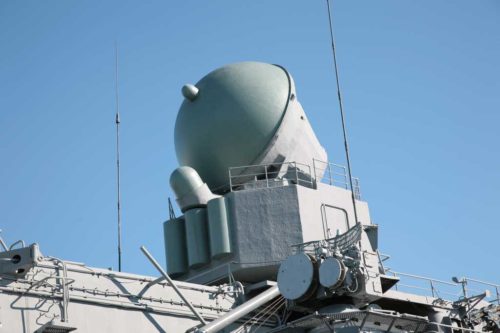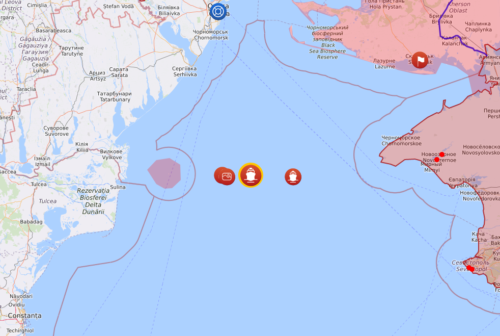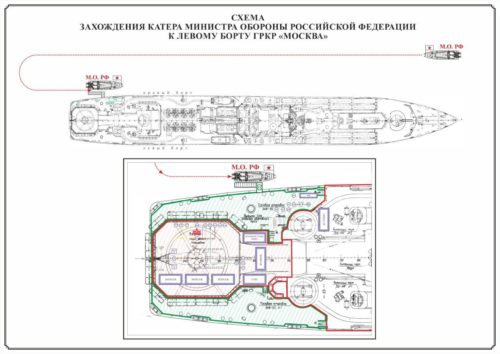I’ve written before here about the sorry state of the Russian Navy. Today we have yet another example in the sinking of a dirty 1970s “Slava-class” bathtub built in 1983.
…a huge morale and propaganda boost for the Ukrainians not only because the Moskva is the flagship of the Black Sea Fleet, but also because this is the same ship from the famous Snake Island incident, when soldiers were recorded telling the Russian warship to “go f*** itself” before being bombarded. The warship is a “symbol of Russian naval power in the Black Sea,” Michael Petersen of the Russia Maritime Studies Institute told to BBC reporters. “The Moskva has been a thorn in the side of the Ukrainians since the beginning of this conflict. To see it damaged so badly… I think is going to be a real morale boost to the Ukrainians.”
Speaking of propaganda, the Moskva (Moscow) symbolically was repaired and modernized in 2020 after being unwisely renamed in 1996 from its original name Slava (glory).
Now, what a ship was christened, so let her stay, I says. — Long John Silver
Perhaps some of the “glory” was gone from this “pride of the Soviet navy” after it was implicated in the 1989 “Seasick Summit“.
Things were even worse 400 yards away aboard the Soviet cruiser Slava, chosen to co-host the summit because of its space-based communications systems that have made it the pride of the Soviet navy. Gorbachev was forced to abandon several attempts to reach the 11,000-ton cruiser, taking refuge on the Soviet passenger liner Maxim Gorky, which was docked in the harbor.
While carrying the admiral’s flag, one of the most important features of Moskva was its Soviet-era S-300F wide-area radar defense capabilities meant to protect the Black Sea fleet.

Loss of radar is a huge setback. Russian defense capabilities had been fraught with incompetence already, and now have even less to work with. This potentially shows again Ukrainian defense dominance using light and agile air campaigns to destroy even the largest and most expensive Russian offensive operations.
What we know mainly is that on April 13th a fire broke out with still uncertain causes.
Ukraine naturally suggested it deserved some credit, saying it had diverted the ship using a Bayraktar TB2 drone before hitting it with a modern anti-ship missile (a R-360 Neptune, arguably based on a Soviet Zvezda Kh-35 / AS-20 Kayak).
If true it would be their second successful coastline defense move.
Earlier reports on sinking of the Russian amphibious landing vessel Saratov indicated Ukraine hit it with a Tochka ballistic missile
Notably that Neptune missile was commissioned in 2013 by Ukraine (preceding the 2014 invasion by Russia) specifically to defend its southern coast against Russian ships, and went into service by 2019.
Like a sea bird using “ground effect” as it flies just above the water the Neptune skims the Black Sea surface, meaning targeting during notoriously stormy weather works in its favor in two distinct ways. A water skimming feature makes it even harder to detect in waves and waterline damage in storms is even more likely to cause sinking exactly like what was observed here.
The Pentagon initially had suggested “the ship is able to make its own way, and it is doing that”.
Yet Odessa OVA Maxim Marchenko observed a serious fire was still burning, and the cruiser indeed sank soon after. It sank quickly enough and in rough conditions such that a nearby cutter reported it rescued only about a dozen of the more than 500 on board, taking them to Sevastopol.
LiveUAmap adds that the Russian Defense Ministry reported it only as “sank while being towed in a storm“.

Given Ukraine mentioned their drone in the operation, and other ships nearby, it is at least plausible that there will someday be footage available to confirm whether a Neptune was involved.
Even more to the point perhaps, given how out in the open cyber warfare (intelligence operations) have been during this war, Jeffery Carr provocatively suggests Ukraine hacked Russian communication channels over two months ago enabling them to seek and destroy the Moskva. He offers evidence of the hack, such as this Russian diagram, for a fee.
